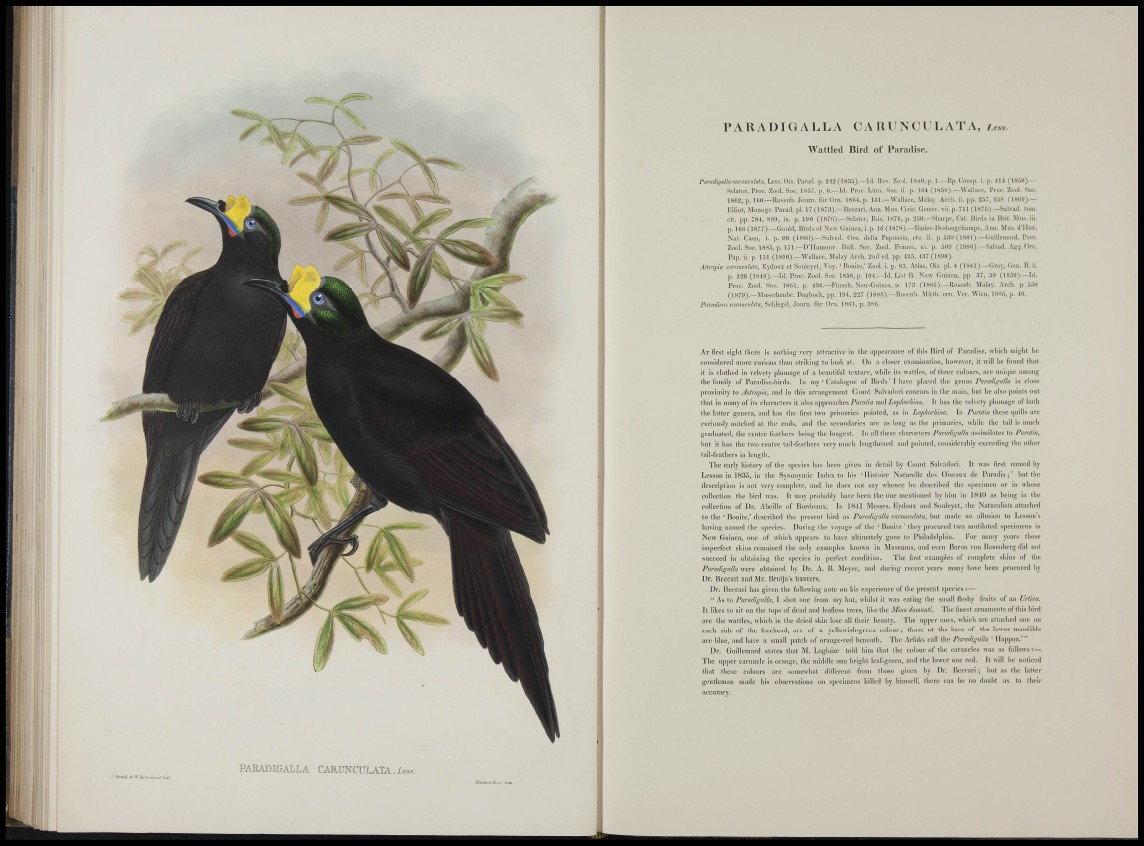
Il il,.:
r r '
il',
\ ' 'rìlilf)
1-, . N I R '
iiiii
il ! •
• I r^uU rf if lioridflM liti.
P A B A D I G A L L A CAMIFCULATA., le.%^.
PARADIGALLA CARUNCULATA, Less.
Wattled Bird of Paradise.
Pamdigdlacaruncnlata, Less. Ois. Pararl. p. 242 (1 8:i5).—111. llev. Zool. 1810, p, 1.—Bp. Consp. i. p. 414 (1850).—
Sdater, Proc, Zool. Soc. 1857, p. (i.—Id. Prue. Linn. Soc. ü. [). Ki l (1858).—Wallace, Prue. Zoül. Soc.
18()2, p. Hiü.—Roseiib. .louni. für Ora. 1804, p. l:il.—Wallace, Malay Arch. ii. pp. 257, 258 (1801)).—
Elliot, Monogr. Parad. pi. 17 (1873).—Beccari , Ann. Mus. Civic. Gcnov. tü. p. 711 (1875).—Salvad. turn,
cit. pp. 784, 899, ix. p. 190 (187(i).—Sclater, Iljis, 1876, p. 250.—Sharpc, Cat. Birds in Brit. Mus. iii.
p. l(iü (1877).—Gould, Birds of New Guinea, i.p. 10 (1878).—Eudcs-Ueslongchamps, Ann, Mus. d'llist.
Nat. Caen, i. p. 20 (1680).—Sahad. Orn. della Papuasia, etc. ii. p. 5:)0 (1881).—Guillcmard, Pore.
Zool. Soe. 1885, p. 151.—D'Hanionv. Bull. Soc. Zool. France, xi. p. 509 (1880).—Salvad. Agg. Orn.
Pap. ii. p. 151 (1890).—Wallace, Malay Arch. 2nd ed. pp. 435, 437 (1890).
Astrapia canineuMa, Eydoux et Soulcyct, Voy. ' Bonitc,' Zool. i. p. 83, Atlas, Ois. pi. 4 (1811).—Gray, Gen. B. li.
p. 320 (1840).—Id. Proc. Zool. Soc. 1S58, p. 11)4.-Id. List B. New Guinea, pp. 37, 50 (1859).—Id.
Proc. Zool. Soc. 1801, p. 430.—Finsch, Neu-Guinea, p. 173 (1885).—Rosenh. Malay. Arch. p. 558
(187!)).—Musschetd)!-. Dagboelc, pp. 194, 227 (1 883).—Rosenb. Mitth. orn. Ver. Wien, 1885, p. 40.
Paradisea carnnculata, Schlegel, .lourn. für Orn. 1801, p. 380.
AT first sight lliere is nolliing very atlruclive in the ap|)enraiice of this Hircl of Paradise, nhich might he
coMsiderod more curious than striliiiig to look at. On a closer exiimination, however, it will he found that
it is clothed in velvety plumage of a heautiful texture, while its wattles, of tliree colours, are unique among
the family of Paradise-hii-ds. In my ' Catalogue of Birds' I have placed the gcmis Parai/igalia in close
proximily to Astrapia, and in this arrangement Count Salvadori concurs in the main, hut he also points out
that in many of its characlers it also api)roaches Purotia and Lophorhimi. It has the velvety plun)age of hoth
the latter genera, and has the first two priuuiries pointed, as in Lophorhina. In Parotia these quills are
curiously notched at the ends, and the secondaries are as long as the primaries, wliile the tail is much
graduated, the centre feathers heing the longest. In all these characters Paradigalla assiuiilates to Purotia,
hut it has the two centre tail-feallio's very much lengtliened and j)ointed, considerahly exceeding the other
tail-feathers in lengtli.
The early history of the species has heen given in detail hy Count Salvadori. It was first named hy
Lesson in 1835, in the Synonymic Index to his 'Histoire Naturelle des Oiseaux de I'aradis ; ' but the
description is not very complete, and he does not say whence he descrihetl the specimen or In ivhose
collection tile hird was. It tiiay probably have been the one mentioned by hitii in 1810 as being in the
collection of Dr. Abeille of Bordeaux. In 1841 Messi's. Eydoux and Soiileyet, tlie Naturalists attached
to the ' lionite,' described the present hird as ParaiTigalla caronadata, hut made no allusioti to Lesson's
having luimed the species. During ihe voyage of the ' Boni le' they procured two mutilated specimens in
New Guinea, one of wliich appears to have ultimately gone to Philadelphia. For many years these
imj)erfect sliins remained the only examples known in Museums, and even Baron von Ilosenbcrg did not
succeed in obtaining the species in perfect condition. The first examples of complete skins of the
Paradigalla were obtained by Dr. A. B. Meyer, and during recent years many have been procured liy
Dr. Beccai i and Mr. Bruiju's hunters.
Di". Becea)-! has given the following note on his experience of the present species:—
" As to Paradigalla, 1 shot one from my hut, whilst it was eating the snuill fleshy fruits of an Urtica,
I t likes to sit on the tops of dead and leafless trees, like the Mino dumonti. The fitiest ornaments of this bird
are the wattles, which in the dried skin lose all their beauty. The )q)pcr 0)ics, which are attached one on
each side of the foi-ehead, are of a yellowish-green colour; those at the base of the lower mandihle
a r e blue, and have a small patch of orange-red beneath. The Arfaks call the Paradigalla ' Happoa.' "
Dr. Guillcmard states that M. Laglaize told him that ihe colour of the caruncles was as follows:—
The ui)per caruncle is orange, tlie middle one hi-iglit leaf-green, and the lower one red. It will he noticed
that these colours are somewhat different from tliose given hy Dr. Beccari ; but as the hitter
gentleman made his observations on specimens killed by himself, there can be no doubt as to their
accuracy.